Table of Contents
- Introduction: Why Building Blocks for Preschoolers Matter
- The Amazing Developmental Benefits
- Types of Building Blocks for Preschoolers
- Large Wooden Blocks vs Other Materials
- How to Choose the Best Building Blocks for Preschoolers
- Safety Standards and Certifications
- Age-Appropriate Selection Guide
- Classroom and Home Integration
- Maintenance and Care Tips
- Frequently Asked Questions
Introduction: Why Building Blocks for Preschoolers Matter
Building blocks for preschoolers represent one of the most powerful educational tools available in early childhood development. For over a century, these timeless toys have captivated young minds while fostering essential skills that form the foundation for academic success. Whether you’re an educator managing a preschool classroom or a parent seeking quality developmental toys, understanding the profound impact of construction play is crucial.
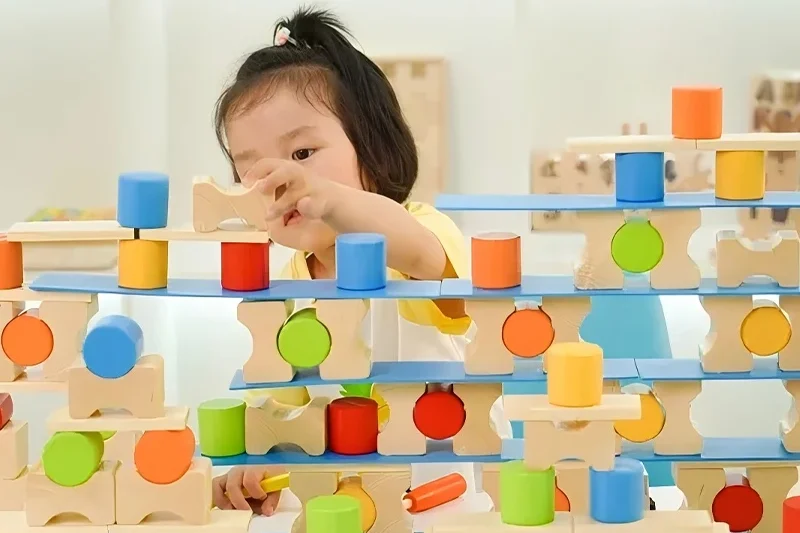
Research from early childhood development experts consistently demonstrates that block play isn’t simply entertainment—it’s a comprehensive learning methodology. Constructive play with blocks activates multiple areas of brain development simultaneously.
The Amazing Developmental Benefits
Cognitive Development Through Construction
When children engage with building blocks for preschoolers, they’re developing critical thinking skills that extend far beyond simple stacking. Each construction decision requires planning, problem-solving, and spatial reasoning. Young builders learn mathematical concepts like symmetry, balance, and proportion without formal instruction.
Scientific studies published in Child Development Research reveal that preschoolers who regularly engage with wooden building blocks score significantly higher on spatial reasoning tests. These skills directly correlate with later mathematics achievement and engineering aptitude.
Fine and Gross Motor Skill Enhancement
Large wooden blocks for preschool environments provide exceptional opportunities for physical development. Carrying, stacking, and arranging blocks strengthens hand-eye coordination and fine motor control—essential precursors to writing skills.
For toddlers and younger preschoolers, manipulating wooden building blocks for preschoolers develops:
- Pincer grasp refinement
- Bilateral coordination
- Muscle strength in hands and fingers
- Spatial awareness through physical movement
Social-Emotional Growth
Collaborative block building teaches invaluable social skills. Children learn to negotiate, share resources, communicate ideas, and work toward common goals. These interpersonal competencies form the bedrock of emotional intelligence.
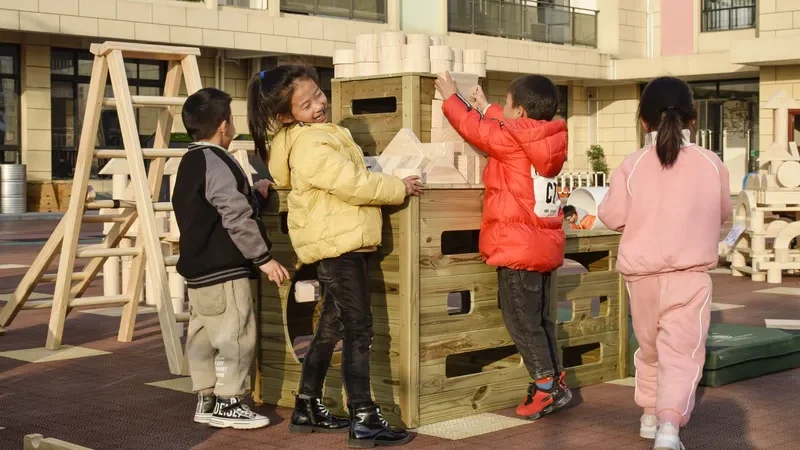
Types of Building Blocks for Preschoolers
Unit Blocks: The Foundation of Quality Block Play
Unit blocks represent the gold standard in educational construction materials. Manufactured to precise mathematical ratios, these wood building blocks for preschoolers teach fractional relationships naturally. A double unit measures exactly twice the length of a single unit, while a quadruple unit measures four times as long.
Premium manufacturers produce unit blocks from solid hardwood, typically maple or birch. These investment-quality materials withstand decades of intensive classroom use.
Large Hollow Blocks for Preschool
Large hollow blocks for preschool settings enable full-body engagement and dramatic play integration. These oversized construction pieces allow children to build life-sized structures like houses, castles, and vehicles they can actually enter and inhabit.
The hollow design reduces weight while maintaining stability, making them safe for preschoolers to manipulate independently. Quality hollow blocks meet strict safety standards and feature smooth, rounded edges.
Wooden Building Blocks for Adults and Intergenerational Play
Increasingly, wooden building blocks for adults are gaining recognition as family bonding tools and therapeutic interventions. Complex architectural block sets engage multiple generations, creating meaningful shared experiences. These sophisticated sets often include specialized shapes like arches, pillars, and curves that challenge advanced builders.
Interlocking Building Blocks Construction Systems
Interlocking building blocks construction systems offer different play experiences than traditional stacking blocks. These connecting blocks for toddlers snap together, allowing more stable vertical construction and complex geometric designs.
While plastic interlocking systems dominate this category, wooden alternatives exist that combine the natural aesthetic of wood with connection mechanisms. These hybrid designs appeal to Montessori and Waldorf educational philosophies.
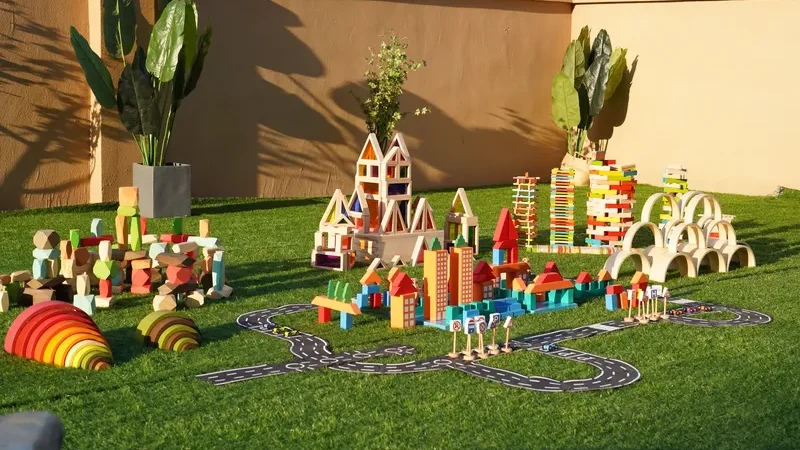
Large Wooden Blocks vs Other Materials
The Timeless Appeal of Natural Wood
Large wooden building blocks offer sensory qualities that synthetic materials cannot replicate. The natural texture, weight, and warmth of wood provide tactile feedback that enhances the building experience. Quality hardwood blocks emit a satisfying sound when they connect or fall, providing immediate auditory feedback that children find deeply engaging.
Environmental considerations also favor wooden options. Sustainable forestry practices ensure these toys represent eco-friendly choices that align with modern values. Unlike plastic alternatives, wooden building blocks for preschoolers are biodegradable and often manufactured from renewable resources.
Plastic Building Blocks: Practical Considerations
Large plastic blocks for toddlers excel in specific contexts. They’re lightweight, easy to sanitize, and weather-resistant for outdoor use. Many preschool programs maintain both wooden and plastic block collections, deploying each type strategically based on planned activities.
However, plastic lacks the heft and stability that characterizes quality wooden blocks. The reduced weight can make tall structures more prone to toppling, potentially frustrating ambitious young builders.
Foam Blocks for Youngest Learners
Soft foam blocks serve specialized purposes in infant and toddler environments. Their cushioned construction prevents injuries during early exploration phases. However, foam blocks provide less satisfying stacking experiences for preschoolers who have developed sufficient motor control for wooden alternatives.
According to ASTM International toy safety standards, all construction toys marketed for children under three must meet strict safety protocols regarding size, materials, and finish treatments.
How to Choose the Best Building Blocks for Preschoolers
Quantity Matters: How Many Blocks Do You Need?
Educational consultants recommend specific quantities based on classroom size and child age:
- 2-year-olds: Minimum 200 blocks
- 3-year-olds: Minimum 300 blocks
- 4-5 year-olds: Minimum 400 blocks
For home use, smaller collections of 50-100 quality pieces provide adequate building opportunities for 1-2 children. The key is ensuring sufficient variety in shapes and sizes to enable diverse construction projects.
Shape Variety and Mathematical Relationships
Premium building blocks for preschoolers sets emphasize foundational shapes: units, double units, quadruple units, half units, and quarter units. These mathematically-proportioned pieces teach fractional concepts through hands-on manipulation.
Advanced sets incorporate specialized shapes like arches, cylinders, curves, and triangular blocks. However, beginners benefit most from simple geometric forms that stack predictably.
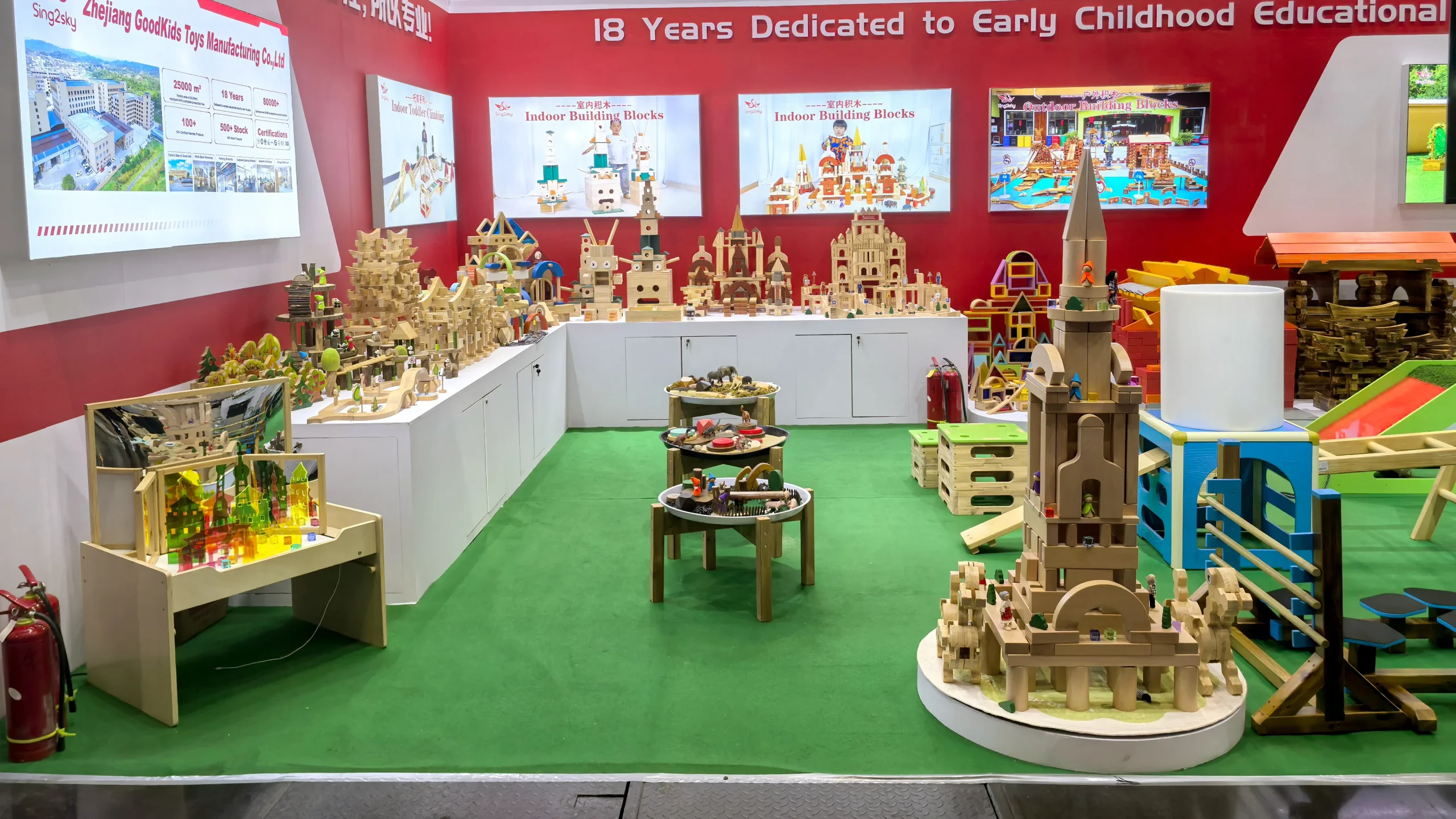
Budget-Conscious Acquisition Strategies
Quality wooden building blocks represent significant investments. Strategic purchasing approaches include:
- Starter Sets: Begin with foundational collections (80-120 pieces)
- Gradual Expansion: Add supplementary shapes quarterly
- Open Stock Purchasing: Buy individual replacement pieces as needed
- Grant Funding: Educational institutions can seek funding through DonorsChoose or local education foundations
Online Purchasing Considerations
When searching for building blocks for preschoolers Amazon or other online retailers, verify:
- Manufacturer reputation and reviews
- Safety certification documentation
- Return policies for damaged merchandise
- Shipping costs for heavy wooden materials
Many buyers successfully locate building blocks for preschoolers nearby through specialty educational supply stores that allow hands-on inspection before purchase.
Safety Standards and Certifications
Critical Safety Certifications
All building blocks for preschoolers sold in North America must comply with Consumer Product Safety Commission (CPSC) regulations. Key standards include:
- ASTM F963: Comprehensive toy safety specification
- CPSIA Compliance: Lead content and phthalate restrictions
- GREENGUARD Certification: Low chemical emissions for indoor air quality
Manufacturers must provide third-party testing documentation verifying compliance. Reputable suppliers prominently display certification information.
Material Safety Considerations
Premium wooden blocks utilize:
- Lead-free finishes: Water-based stains and natural oils
- Non-toxic adhesives: When laminated construction is employed
- Sustainably harvested hardwoods: FSC-certified when available
Avoid blocks finished with unknown coatings or those lacking safety documentation. The natural wood aroma of quality blocks differs markedly from chemical off-gassing smells that indicate problematic treatments.
Age-Appropriate Sizing
For children under 36 months, large building blocks for preschoolers must exceed 1.75 inches in all dimensions to prevent choking hazards. This regulatory requirement explains why toddler-specific block sets feature oversized pieces compared to preschool versions.
Age-Appropriate Selection Guide
Building Blocks for 5 Year Olds and Older Preschoolers
Building blocks for 5 year olds should challenge advancing skills while maintaining achievable goals. At this developmental stage, children benefit from:
- Smaller, more numerous pieces enabling detailed construction
- Specialty shapes supporting architectural elements
- Integration with dramatic play accessories (people figures, vehicles)
- Pattern cards or challenge cards inspiring specific builds
Five-year-olds possess sufficient impulse control and motor precision for more delicate constructions. They derive satisfaction from replicating real-world structures and creating elaborate scenarios.
Developmental Progression in Block Play
Research identifies distinct stages in block play development:
Stage 1 (18-24 months): Carrying and dumping
Stage 2 (2-3 years): Simple stacking and rows
Stage 3 (3-4 years): Bridges and enclosures
Stage 4 (4-5 years): Complex patterns and representations
Stage 5 (5-7 years): Detailed reproductions and collaborative mega-projects
Understanding these stages helps educators and parents provide appropriate scaffolding and materials.
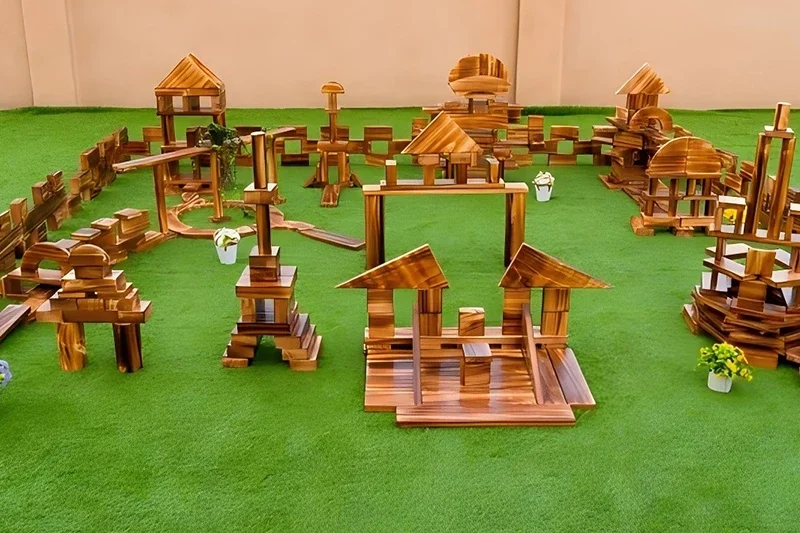
Classroom and Home Integration
Creating Effective Block Centers
Successful block centers require thoughtful spatial design:
- Adequate Floor Space: Minimum 8′ x 10′ area for group building
- Low Shelving: Open access to organized block collections
- Visual Supports: Photographs of past constructions inspire creativity
- Complementary Materials: Add people figures, vehicles, and natural materials
For diy building blocks for preschoolers projects, cardboard boxes, milk cartons, and wooden scraps provide cost-effective supplementary materials. These additions encourage creativity while extending limited budgets.
Curriculum Integration Strategies
Exceptional educators weave block play throughout curriculum areas:
- Mathematics: Counting, sorting, patterns, measurement
- Science: Gravity, balance, cause-and-effect, simple machines
- Literacy: Labeling structures, creating stories, reading block-themed books
- Social Studies: Building community structures, cultural architecture
- Art: Symmetry, design principles, three-dimensional composition
This integrated approach maximizes the educational value of wood building blocks for preschoolers while justifying the investment to administrators and parents.
Outdoor Block Play Possibilities
Weather-resistant materials expand learning beyond classroom walls. Large outdoor blocks encourage gross motor development and collaborative construction on a grand scale. Many programs successfully utilize:
- Cinder blocks (smoothed edges)
- Wooden planks and stumps
- Large cardboard boxes (replaced seasonally)
- Hollow plastic blocks rated for outdoor use
Maintenance and Care Tips
Cleaning and Sanitizing Procedures
Wooden blocks require gentle cleaning methods that preserve finish integrity:
- Regular Maintenance: Wipe with slightly damp cloth
- Disinfection: Use diluted vinegar solution (1:4 ratio)
- Drying: Air dry thoroughly before storage
- Avoid: Harsh chemicals, submersion in water, dishwasher cleaning
Monthly inspection identifies damaged pieces requiring refinishing or removal. Sand smooth any rough edges that develop over time.
Storage Solutions
Proper storage extends block longevity while teaching organization skills:
- Open shelving: Sort by shape on labeled shelves
- Bins and baskets: Group similar pieces together
- Storage carts: Mobile units facilitate classroom flexibility
- Silhouette labels: Visual guides aid cleanup independence
Frequently Asked Questions
Q: Where can I find building blocks for preschoolers nearby?
A: Check local educational supply stores, teacher resource centers, and specialty toy retailers. Many communities have businesses specifically serving schools and daycares.
Q: Are large wooden building blocks safe for 3-year-olds?
A: Yes, when properly sized and finished. Ensure blocks exceed choking hazard dimensions and feature smooth, rounded edges. Quality manufacturers design specifically for preschool age groups.
Q: How do wooden building blocks for adults differ from children’s versions?
A: Adult-oriented sets typically feature more complex shapes, smaller dimensions, and architectural elements. They appeal to collectors and families seeking intergenerational activities.
Q: What’s the difference between connecting blocks for toddlers and traditional wooden blocks?
A: Connecting blocks incorporate interlocking mechanisms for more stable construction. Traditional blocks rely on gravity and balance, teaching different engineering principles.
Q: Can I make DIY building blocks for preschoolers at home?
A: Yes! Use untreated lumber cut into various rectangular shapes. Sand thoroughly, apply non-toxic finish, and verify dimensions meet safety standards before use.
Q: How do interlocking building blocks construction systems support learning?
A: They teach engineering concepts, develop fine motor skills, and allow three-dimensional design exploration. The connection mechanisms add complexity to construction challenges.
Conclusion: Investing in Lifelong Learning
Building blocks for preschoolers represent far more than simple toys—they’re powerful educational instruments that shape developing minds. Whether you select large wooden blocks for preschool classrooms or curate collections for home learning, prioritizing quality materials and age-appropriate designs ensures optimal developmental outcomes.
The initial investment in premium wooden building blocks for preschoolers pays dividends across multiple developmental domains. These durable materials serve multiple children over many years, making them economically sound despite higher upfront costs.
As you evaluate options—from large plastic blocks for toddlers to sophisticated wooden building blocks for adults—remember that the best choices align with your specific educational goals, available space, and budget constraints. Start with quality foundational pieces and expand thoughtfully as needs evolve.

About Our Wooden Educational Blocks Manufacturing
As a leading Chinese manufacturer of premium wooden educational toys, we specialize in creating high-quality building blocks for preschoolers that meet international safety standards and exceed educator expectations. Our factory utilizes sustainable hardwoods, non-toxic finishes, and precision manufacturing to produce blocks that inspire learning across generations.
We offer:
- Custom block sets designed for specific curriculum needs
- Bulk purchasing options for educational institutions
- International shipping to kindergartens and distributors worldwide
- CE, EN71, and ASTM certification documentation
Contact us today to discuss your educational building block needs and receive a customized quote for your program.